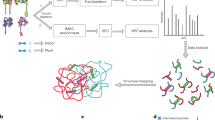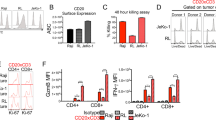Abstract
Cancer-specific cell-surface antigens are ideal targets for monoclonal antibody (mAb)-based immunotherapy but are likely to have previously been identified in transcriptome or proteome analyses. Here, we show that the active conformer of an integrin can serve as a specific therapeutic target for multiple myeloma (MM). We screened >10,000 anti-MM mAb clones and identified MMG49 as an MM-specific mAb specifically recognizing a subset of integrin β7 molecules. The MMG49 epitope, in the N-terminal region of the β7 chain, is predicted to be inaccessible in the resting integrin conformer but exposed in the active conformation. Elevated expression and constitutive activation of integrin β7 conferred high MMG49 reactivity on MM cells, whereas MMG49 binding was scarcely detectable in other cell types including normal integrin β7+ lymphocytes. T cells transduced with MMG49-derived chimeric antigen receptor (CAR) exerted anti-MM effects without damaging normal hematopoietic cells. Thus, MMG49 CAR T cell therapy is promising for MM, and a receptor protein with a rare but physiologically relevant conformation can serve as a cancer immunotherapy target.
This is a preview of subscription content, access via your institution
Access options
Access Nature and 54 other Nature Portfolio journals
Get Nature+, our best-value online-access subscription
$29.99 / 30 days
cancel any time
Subscribe to this journal
Receive 12 print issues and online access
$209.00 per year
only $17.42 per issue
Buy this article
- Purchase on Springer Link
- Instant access to full article PDF
Prices may be subject to local taxes which are calculated during checkout





Similar content being viewed by others
References
Scott, A.M., Wolchok, J.D. & Old, L.J. Antibody therapy of cancer. Nat. Rev. Cancer 12, 278–287 (2012).
Porter, D.L., Levine, B.L., Kalos, M., Bagg, A. & June, C.H. Chimeric antigen receptor-modified T cells in chronic lymphoid leukemia. N. Engl. J. Med. 365, 725–733 (2011).
Grupp, S.A. et al. Chimeric antigen receptor-modified T cells for acute lymphoid leukemia. N. Engl. J. Med. 368, 1509–1518 (2013).
Kandoth, C. et al. Mutational landscape and significance across 12 major cancer types. Nature 502, 333–339 (2013).
Lawrence, M.S. et al. Mutational heterogeneity in cancer and the search for new cancer-associated genes. Nature 499, 214–218 (2013).
Meacham, C.E. & Morrison, S.J. Tumour heterogeneity and cancer cell plasticity. Nature 501, 328–337 (2013).
Posey, A.D. Jr. et al. Engineered CAR T cells targeting the cancer-associated Tn-glycoform of the membrane mucin MUC1 control adenocarcinoma. Immunity 44, 1444–1454 (2016).
Palumbo, A. & Anderson, K. Multiple myeloma. N. Engl. J. Med. 364, 1046–1060 (2011).
Rajkumar, S.V. Treatment of multiple myeloma. Nat. Rev. Clin. Oncol. 8, 479–491 (2011).
Dimopoulos, M.A., Richardson, P.G., Moreau, P. & Anderson, K.C. Current treatment landscape for relapsed and/or refractory multiple myeloma. Nat. Rev. Clin. Oncol. 12, 42–54 (2015).
Schweighoffer, T. et al. Selective expression of integrin alpha 4 beta 7 on a subset of human CD4+ memory T cells with hallmarks of gut-trophism. J. Immunol. 151, 717–729 (1993).
Erle, D.J. et al. Expression and function of the MAdCAM-1 receptor, integrin alpha 4 beta 7, on human leukocytes. J. Immunol. 153, 517–528 (1994).
Takagi, J., Petre, B.M., Walz, T. & Springer, T.A. Global conformational rearrangements in integrin extracellular domains in outside-in and inside-out signaling. Cell 110, 599–511 (2002).
Shimaoka, M., Takagi, J. & Springer, T.A. Conformational regulation of integrin structure and function. Annu. Rev. Biophys. Biomol. Struct. 31, 485–516 (2002).
Tidswell, M. et al. Structure-function analysis of the integrin beta 7 subunit: identification of domains involved in adhesion to MAdCAM-1. J. Immunol. 159, 1497–1505 (1997).
Chen, J., Salas, A. & Springer, T.A. Bistable regulation of integrin adhesiveness by a bipolar metal ion cluster. Nat. Struct. Biol. 10, 995–1001 (2003).
Qi, J. et al. Identification, characterization, and epitope mapping of human monoclonal antibody J19 that specifically recognizes activated integrin α4β7. J. Biol. Chem. 287, 15749–15759 (2012).
Honda, S. et al. Topography of ligand-induced binding sites, including a novel cation-sensitive epitope (AP5) at the amino terminus, of the human integrin beta 3 subunit. J. Biol. Chem. 270, 11947–11954 (1995).
Berlin, C. et al. Alpha 4 beta 7 integrin mediates lymphocyte binding to the mucosal vascular addressin MAdCAM-1. Cell 74, 185–195 (1993).
Hurt, E.M. et al. Overexpression of c-maf is a frequent oncogenic event in multiple myeloma that promotes proliferation and pathological interactions with bone marrow stroma. Cancer Cell 5, 191–199 (2004).
Neri, P. et al. Integrin β7-mediated regulation of multiple myeloma cell adhesion, migration, and invasion. Blood 117, 6202–6213 (2011).
Wagner, N. et al. Critical role for β7 integrins in formation of the gut-associated lymphoid tissue. Nature 382, 366–370 (1996).
Morin, N.A. et al. Nonmuscle myosin heavy chain IIA mediates integrin LFA-1 de-adhesion during T lymphocyte migration. J. Exp. Med. 205, 195–205 (2008).
Morgan, R.A. et al. Case report of a serious adverse event following the administration of T cells transduced with a chimeric antigen receptor recognizing ERBB2. Mol. Ther. 18, 843–851 (2010).
Maher, J., Brentjens, R.J., Gunset, G., Rivière, I. & Sadelain, M. Human T-lymphocyte cytotoxicity and proliferation directed by a single chimeric TCRζ/CD28 receptor. Nat. Biotechnol. 20, 70–75 (2002).
Liu, X. et al. Affinity-tuned ErbB2 or EGFR chimeric antigen receptor T cells exhibit an increased therapeutic index against tumors in mice. Cancer Res. 75, 3596–3607 (2015).
Johnsen, H.E. et al. The myeloma stem cell concept, revisited: from phenomenology to operational terms. Haematologica 101, 1451–1459 (2016).
Bergsagel, P.L. et al. In multiple myeloma, clonotypic B lymphocytes are detectable among CD19+ peripheral blood cells expressing CD38, CD56, and monotypic Ig light chain. Blood 85, 436–447 (1995).
Rapoport, A.P. et al. NY-ESO-1–specific TCR–engineered T cells mediate sustained antigen-specific antitumor effects in myeloma. Nat. Med. 21, 914–921 (2015).
Garfall, A.L. et al. Chimeric antigen receptor T cells against CD19 for multiple myeloma. N. Engl. J. Med. 373, 1040–1047 (2015).
Carpenter, R.O. et al. B-cell maturation antigen is a promising target for adoptive T-cell therapy of multiple myeloma. Clin. Cancer. Res. 19, 2048–2060 (2013).
Ali, S.A. et al. T cells expressing an anti-B-cell maturation antigen chimeric antigen receptor cause remissions of multiple myeloma. Blood 128, 1688–1700 (2016).
Chu, J. et al. Genetic modification of T cells redirected toward CS1 enhances eradication of myeloma cells. Clin. Cancer. Res. 20, 3989–4000 (2014).
Kinashi, T. Intracellular signalling controlling integrin activation in lymphocytes. Nat. Rev. Immunol. 5, 546–559 (2005).
Jungbluth, A.A. et al. A monoclonal antibody recognizing human cancers with amplification/overexpression of the human epidermal growth factor receptor. Proc. Natl. Acad. Sci. USA 100, 639–644 (2003).
Johns, T.G. et al. Identification of the epitope for the epidermal growth factor receptor-specific monoclonal antibody 806 reveals that it preferentially recognizes an untethered form of the receptor. J. Biol. Chem. 279, 30375–30384 (2004).
Coffman, K.T. et al. Differential EphA2 epitope display on normal versus malignant cells. Cancer Res. 63, 7907–7912 (2003).
Chow, K.K. et al. T cells redirected to EphA2 for the immunotherapy of glioblastoma. Mol. Ther. 21, 629–637 (2013).
Gan, H.K., Burgess, A.W., Clayton, A.H. & Scott, A.M. Targeting of a conformationally exposed, tumor-specific epitope of EGFR as a strategy for cancer therapy. Cancer Res. 72, 2924–2930 (2012).
Garrett, T.P. et al. Antibodies specifically targeting a locally misfolded region of tumor associated EGFR. Proc. Natl. Acad. Sci. USA 106, 5082–5087 (2009).
Luo, B.H., Carman, C.V. & Springer, T.A. Structural basis of integrin regulation and signaling. Annu. Rev. Immunol. 25, 619–647 (2007).
Schultze, J.L. et al. CD40-activated human B cells: an alternative source of highly efficient antigen presenting cells to generate autologous antigen-specific T cells for adoptive immunotherapy. J. Clin. Invest. 100, 2757–2765 (1997).
Kitamura, T. et al. Efficient screening of retroviral cDNA expression libraries. Proc. Natl. Acad. Sci. USA 92, 9146–9150 (1995).
Hemler, M.E. et al. Glycoproteins of 210,000 and 130,000 m.w. on activated T cells: cell distribution and antigenic relation to components on resting cells and T cell lines. J. Immunol. 132, 3011–3018 (1984).
Takagi, J., Erickson, H.P. & Springer, T.A. C-terminal opening mimics 'inside-out' activation of integrin α5β1. Nat. Struct. Biol. 8, 412–416 (2001).
Nagae, M. et al. Crystal structure of α5β1 integrin ectodomain: atomic details of the fibronectin receptor. J. Cell Biol. 197, 131–140 (2012).
Cong, L. et al. Multiplex genome engineering using CRISPR/Cas systems. Science 339, 819–823 (2013).
Kowolik, C.M. et al. CD28 costimulation provided through a CD19-specific chimeric antigen receptor enhances in vivo persistence and antitumor efficacy of adoptively transferred T cells. Cancer Res. 66, 10995–11004 (2006).
Terakura, S. et al. Generation of CD19-chimeric antigen receptor modified CD8+ T cells derived from virus-specific central memory T cells. Blood 119, 72–82 (2012).
Hosen, N. et al. CD48 as a novel molecular target for antibody therapy in multiple myeloma. Br. J. Haematol. 156, 213–224 (2012).
Acknowledgements
We thank the Kinki Cord Blood Bank for CB samples and T. Yamane (Osaka City General Hospital) and K. Koh (Osaka General Hospital for West Japan Railway Company) for MM samples. We also thank K. Terasaki, S. Ikeda, Y. Hayami, R. Inada, R. Urakawa, S. Hashiguchi, M. Iwai, and A. Kosugi for technical assistance, and Y. Kanakura (Osaka University), R. Burger (University of Kiel), I. Weissman (Stanford University), T. Kitamura (Tokyo University), and the NIH AIDS Reagents program for providing materials. This work was supported in part by a Grant-in-Aid for Scientific Research on Innovative Areas (Analysis and Synthesis of Multidimensional Immune Organ Network) from the Ministry of Education, Culture, Sports, Science and Technology of Japan (to J.T.); the Project for Development of Innovative Research on Cancer Therapeutics and Practical Research for Innovative Cancer Control from the Japan Agency for Medical Research and Development AMED (to N.H.); JSPS KAKENHI grant JP26461404 (to N.H.); and Japan Agency for Medical Research and Development–Core Research for Evolutional Science and Technology grant 15652237 (to A.K.).
Author information
Authors and Affiliations
Contributions
N.H. and J.T. designed the experiments; N.H., Y.M., K.H., H.M., Y.N., M. Makita., K.W., M.Y., K.S., S.M., F.F., H.N., J.Nakata., S.N., A.T., Y.Oka., R.U., K.O., Y.B., S.T., N.W., E.M., J.Nishimura., and Y.Oji. performed the experiments; M.Manabe., H.I., Y.A., A.M., T.N., and M.H. collected and analyzed clinical samples; N.H., Y.M., K.H., and J.T. analyzed the data; N.H., Y.M., K.H., K.T., H.S., J.T., and A.K. wrote the manuscript; and all authors reviewed and approved the final version of the manuscript.
Corresponding author
Ethics declarations
Competing interests
N.H., H.S., J.T., and A.K. have applied for a Japanese patent entitled 'Antibody' through the Osaka University Office for University-Industry Collaboration. The other authors declare no competing financial interests.
Supplementary information
Supplementary Figures
Supplementary Figures 1–15 (PDF 18939 kb)
Rights and permissions
About this article
Cite this article
Hosen, N., Matsunaga, Y., Hasegawa, K. et al. The activated conformation of integrin β7 is a novel multiple myeloma–specific target for CAR T cell therapy. Nat Med 23, 1436–1443 (2017). https://doi.org/10.1038/nm.4431
Received:
Accepted:
Published:
Issue Date:
DOI: https://doi.org/10.1038/nm.4431
This article is cited by
-
Identification of cancer-specific cell surface targets for CAR-T cell therapy
Inflammation and Regeneration (2024)
-
Matrix stiffness affects tumor-associated macrophage functional polarization and its potential in tumor therapy
Journal of Translational Medicine (2024)
-
Targeting integrin pathways: mechanisms and advances in therapy
Signal Transduction and Targeted Therapy (2023)
-
Prognostic value of extracellular matrix gene mutations and expression in multiple myeloma
Blood Cancer Journal (2023)
-
Structural surfaceomics reveals an AML-specific conformation of integrin β2 as a CAR T cellular therapy target
Nature Cancer (2023)



